[melin & österlin] melbi, johan (red.): John Melin ... - Antikvariat Morris
[melin & österlin] melbi, johan (red.): John Melin ... - Antikvariat Morris
[melin & österlin] melbi, johan (red.): John Melin ... - Antikvariat Morris
You also want an ePaper? Increase the reach of your titles
YUMPU automatically turns print PDFs into web optimized ePapers that Google loves.
john <strong>melin</strong> and anders österlin were<br />
partners in advertising, described as ‘gurus’ of<br />
the 60s and 70s. <strong>Melin</strong> became famous for creating<br />
the Moderna Museet’s first graphic profile,<br />
which looked Swiss-inspi<strong>red</strong>. The ideas were<br />
<strong>John</strong>’s, the drawing Anders’s. They co-operated,<br />
and they were actually known as ‘anden’ and<br />
‘handen’ (the spirit and the hand). As directors<br />
at the advertising and design agencies Svenska<br />
Telegrambyrån and Arbman, together they created<br />
brilliant and accurate designs, full of wit! <strong>John</strong><br />
<strong>Melin</strong>’s ability to find new surprising solutions<br />
for commercial as well as everyday projects has<br />
few counterparts within Swedish graphic design.<br />
Under the signature ‘M&Ö’, they designed posters,<br />
books, catalogues, cardboard packaging and<br />
paper cartons. The catalogues were for artists<br />
like Jean Tinguely, Niki de Saint-Phalle and Andy<br />
Warhol. For ny moma they made a very special<br />
one, called The Machine, which was a piece of<br />
metal. One poster, made for Stockholm Moderna<br />
Museet, had text printed in moist glue, sprinkled<br />
with cress seeds that sprouted, grew green and<br />
then wilted. As well as all this, Anders is also a<br />
painter, who started a Swedish art group called<br />
Imaginisterna. In 1947 he became involved with<br />
the Cobra group, with Appel, Corneille, Jorn and<br />
Constant.<br />
[<strong>melin</strong> & österlin] <strong>melbi</strong>, <strong>johan</strong> (<strong>red</strong>.): <strong>John</strong> <strong>Melin</strong> till Exempel. En<br />
hyllning till det enkla, vackra, lekfulla, konstnärliga, unika, egensinniga, tidlösa,<br />
moderna, experimentella [=omslagstitel]<br />
Hall & Cederquist/Y&R och Moderna Museet, Stockholm 1999. 172 s.<br />
4:o (28 x 25 cm). Trådhäftad med djupa flikomslag. Mycket fint skick.<br />
Rikt illustrerad i färg och svartvitt. Typografi av Claes-Henrik Engquist.<br />
Förord av Pontus Hultén och texter av Johan Melbi, Ragnar von Holten,<br />
Per Henry Richter, Per Mollerup och Anders Wester.<br />
Svensk Bokkonst 1999:10 “En utställningskatalog med ett bra tryck och<br />
en perfekt färgåtergivning. En enkel och elegant volym med roliga detaljer,<br />
titta på pagineringen t.ex.”<br />
Johan Melbis inventering och sammanställning är av största vikt och är ett viktigt<br />
referensverk över en guldålder och ett enastående formgivningsliv.<br />
SEK400 / €47<br />
[<strong>melin</strong> & österlin] stensman, mailis & högestätt, eje (<strong>red</strong>.): 12<br />
svenska skulptörer / 12 Swedish Sculptors<br />
Malmö Konsthall, Katalog nr 4, Malmö 1975. 64 s. 4:o (28 x 21,5 cm). Pärmar<br />
av wellpapp och ryggen förstärkt med gul isoleringstejp (det ska vara<br />
så!). Två sprickor i ryggtejpen. Fotoillustrerad i svartvitt. Svensk och engelsk<br />
parallelltext. Text in Swedish & English. Typografi av <strong>John</strong> <strong>Melin</strong> & Gösta<br />
Svensson. (<strong>John</strong> <strong>Melin</strong> till exempel s. 68).<br />
SEK200 / €24
[<strong>melin</strong> & österlin] hultén, k. g. pontus: The Machine as Seen at the<br />
End of the Mechanical Age<br />
The Museum of Modern Art, New York 1968. (2), 216, (2) pages. Tall<br />
8vo (24,5 x 21,5 cm). Attractive embossed & colour printed metal binding<br />
hinged and pop revied at spine; decorated front cover by Anders Österlin,<br />
after a photo by Alicia Legg. Numerous b/w illustrations and some in blue<br />
& white. Contains work by Calder, Duchamp, Ernst, Feininger, El Lissitzky,<br />
Man Ray, Moholy-Nagy, Picabia, Schwitters, Tatlin, Tinguely and many others.<br />
With notes, bibliography, index. Book design by <strong>John</strong> <strong>Melin</strong> and Gösta<br />
Svensson.<br />
SEK1500 / €178<br />
[<strong>melin</strong> & österlin]: Svenskarna sedda av 11 fotografer. Moderna Museet,<br />
december-februari 1962–63<br />
Moderna Museet, Stockholm, 1962. 269 s. Limhäftad med skyddsomslag.<br />
(24 x 22,5 cm). Fotoillustrerad i svartvitt. De 11 fotograferna är: Sten<br />
Didrik Bellander, Jan Delden, Hans Hammarskiöld, Sune Jonsson, Tore<br />
<strong>John</strong>son, Stig T. Karlsson, Lennart Nilsson, Pål-Nils Nilsson, Lennart Olson,<br />
Lennart af Petersens och Rolf Winquist. Moderna Museet katalog 25.<br />
Typografi av <strong>Melin</strong> & Österlin. (<strong>John</strong> <strong>Melin</strong> till exempel s. 39).<br />
SEK275 / €33<br />
sylwan, barbro - hultén, k. g. - <strong>melin</strong>,<br />
john - österlin, anders (eds.): Hon - en<br />
[katedral] historia<br />
Moderna Museet, Stockholm, 1967. First edition.<br />
208 pages. Folio (37 x 29,5 cm). Stapled.<br />
Spectacular folding pictorial wraps, printed on<br />
newsprint. A little bit wrinkled at head & foot<br />
of spine, a minimal tear at spine’s end otherwise<br />
a really, really nice copy, bright and clean. This<br />
is not the official catalogue from the exhibition<br />
1966, it is the documentation of the exhibition,<br />
it tells the story of the pre-history, the construction<br />
diary, the exhibition and the demolition<br />
of Niki Saint-Phalle’s, Jean Tinguely’s and Per Olof Ultvedt’s installation “Hon-En Historia / Hon-en<br />
Katedral. Hon, She, Elle, Sie, Lei, Zij” held at Moderna Museet in Stockholm in 1966. It’s important because<br />
of the detailed description of the exhibition and the references to media in Sweden and abroad.<br />
Numerous photos by Hans Hammarskiöld, K. G. Hultén, Magnus Wibom, Lutfi Özkök. Text in English<br />
and Swedish. Typography by <strong>Melin</strong> & Österlin (<strong>John</strong> <strong>Melin</strong> till exempel pages 24–29).<br />
SEK1750 / €208 #4665
...another copy<br />
Jacket is a little bit yellowed, shorter tears at top of<br />
spine and with a smaller paper loss, shorter tears at<br />
spine’s end otherwise a nice copy.<br />
SEK900 / €107 #4769<br />
...another copy<br />
Jacket is a little bit yellowed and with a few stains,<br />
shorter tears at top of spine and with a minor paper<br />
loss, otherwise a nice copy.<br />
SEK800 / €95 #4770<br />
...last copy<br />
Jacket yellowed, front cover soiled, end of spine<br />
with a three cm tear, otherwise a nice copy.<br />
SEK600 / €71 #4771<br />
[<strong>melin</strong> & österlin] Personbil 1927 [Däck: Trelleborg<br />
”Ballong” 29x4,75-20]<br />
Trelleborgs Gummifabriks AB, Trelleborg. Litograferad,<br />
i färg, vid mitten av 1960-talet. (96,5<br />
x 52,5 cm.) Knappnålshål i hörnen, yttersta övre<br />
vänsta hörnet med liten pappersförlust, mindre<br />
repskada mitt i övre marginalen, svag minimal<br />
fläck på vita ytan. AB Svenska Telegrambyrån,<br />
Malmö hade det reklam-historiskt legendariska<br />
uppdraget för Trelleborgs Gummifabriks AB.<br />
SEK875 / €104
[<strong>melin</strong> & österlin] Tourist Festival<br />
Restaurang Bill & Bull, Stockholm, utan år (c. 1971–<br />
72). Screentryck på kraftig glanskartong, delvis tryck<br />
med guld och silver. Bladmått h x b: 68,5 x 78,5 cm.<br />
Nedre högra hörn med veck och med mindre marginalbristning.<br />
Nedre vänstra hörn med svag antydan<br />
till veck. Övre marginalreva (c. 15 mm). Produktion:<br />
Arbmans, Malmö. Idé, bild och typografi av <strong>Melin</strong> &<br />
Österlin.<br />
SEK600 / €71<br />
[joh. enschedé en zonen] Proef van nederduitsche letters en Gothische initialen<br />
uit de XVde eeuw / Spécimen de caracteres Flamands et d´initiales Gothiques du<br />
XVme siècle / Probe niederdeutscher Schriften und gothischer Initialen aus dem XVten<br />
Jahrhundert / Specimen of Dutch Black-Letters and Gothic Initials of the XVth Century<br />
Joh. Enschedé en Zonen, Collection Typographique, Haarlem, 1925. 51, (3)<br />
pages + a corrigenda slip tipped-in at the rear. 4to (28 x 20 cm). Bound in<br />
patterned marbled paper over boards, end-leaves lightly browned. No spine<br />
or cover title. Corners bumped and head & foot of spine scuffed. Edges<br />
untrimmed. Printed in <strong>red</strong> & black. Initials drawn by Jan van Krimpen and<br />
printed in <strong>red</strong>. Text in English, Dutch, German and French. (Lane & Lommen<br />
95).<br />
SEK450 / €53<br />
eksell, olle: Design = Ekonomi<br />
Bonniers, Stockholm 1964. 184 s. 4:o. Svart guldförgyllt klotband med<br />
marginalnött skyddsomslag. Illustrerad med författarens egna teckningar<br />
och fotografier av Stig T. Karlsson, Malcolm Smith, Stenbergs,<br />
Erich Hartmann och Lester Beall. Tryckt hos Björkmans Eftr. Typografi,<br />
band, omslag och teckningar av författaren. Originalutgåvan.<br />
Bandet bland 25 utvalda förlagsband 1964. Design=Ekonomi intog<br />
hedersplatsen på bokmässan i Frankfurt 1965. “Under årens lopp har<br />
många frågat efter den (Design=Ekonomi) men den har varit svår att<br />
hitta. Ett fåtal har lyckats på antikvariat. När den gavs ut betraktade<br />
jag den som en form av manifest med de överdrifter som alltid är nödvändiga<br />
för att väcka hösäckar.” Olle Eksell i Platina nr 6, 1996.<br />
SEK450 / €53
schmid, helmut: Calendar 1980<br />
Helmut Schmid, [Osaka (?)], 1980. Front cover followed by six<br />
leafs with two months and an illustration on each page, hold<br />
together by a grey metal rail at top. (37,4 x 36,4 cm). Weak<br />
tendency of a dog ear at lower right corner. The illustrations,<br />
or rather pictures, are bus-, train- and subway tickets, from<br />
Paris, Colombo, New York, Osaka, London, Warsaw.<br />
helmut schmid – born 1942 in Austria as a German citizen.<br />
Studies in Switzerland at the Basel School of Design under<br />
Emil Ruder, Kurt Hauert and Robert Buchler. Works in West<br />
Berlin and Stockholm (covers for Grafisk Revy). After Montreal<br />
(Ernst Roch Design) and Vancouver he works in Osaka<br />
for nia (for Taiho Pharmaceutical and Sanyo). 1973–76 at are<br />
in Dusseldorf he designs publicity material for the German<br />
government and the chancellors Willy Brandt and Helmut Schmidt. 1976 election campaign symbol<br />
for the spd. 1978 exhibition of his politypographien at the Print Gallery in Amsterdam. Independent<br />
designer in Osaka since 1981. Member of agi (Alliance Graphique Internationale) since 1988.<br />
SEK500 / €59<br />
[gill, eric] MacCarthy, Fiona: Eric Gill<br />
SEK200 / €24<br />
Faber and Faber, London, 1990. xiv, 338 pages. + 129 photos on 64 pages of plates.<br />
Tall 8vo. 58 text-illustrations + plates. First paperback-edition. Former owner’s<br />
signature on first end paper. Nice and unopened copy. The biography of one of the<br />
1900s most interesting and ingenious artists. The book caused a stir when it came<br />
out because Fiona MacCarthy not refrained for less known or recognized sides of<br />
Eric Gill, but necessary to get an overall picture of this complexed man, or as Eric<br />
Gill said in one of his many proverbs; “It all goes together”. (Gill, Corey & Mackenzie<br />
636.135).<br />
[melbert b. cary, jr. graphic arts collection] A Specimen<br />
Portfolio of Wood Type in the Cary Collection<br />
rit Cary Graphic Arts Press, 2010. xx, 305 pages. 4to (28 x 22 cm).<br />
Spiral bound. Includes an introduction and classification system<br />
used by permission of David P. Wall. Foreword by R. Roger Remington.<br />
New copy.<br />
Wood type in myriad designs—from stark condensed sans serifs to<br />
bizarre ornamental scripts—created variety in commercial advertising<br />
more than 180 years ago, and continues today to influence modern<br />
signs, posters, and billboards. The Melbert B. Cary, Jr. Graphic<br />
Arts Collection at rit maintains an impressive collection of wood<br />
type, numbering over 300 fonts. This book showcases over 250 of<br />
our best wood type specimens, including many complete fonts and<br />
samples from unusual designs. All specimen reproductions were<br />
painstakingly printed from the original wood type blocks, some distressed<br />
with 100 years of use and abuse. The resulting compendium is a rich typographic resource sure<br />
to delight any designer, scholar, collector and student of graphic arts history.<br />
SEK225 / €27
[nitsche, erik]<br />
1. Skepp och sjöfart 2. Luftfart 3. Astronomi 4. Elektricitet 5.<br />
Hjulet 6. Medicin 7. Raketer och rymdfart 8. Kemi 9. Vapen<br />
10. Ord, bild och massmedia 11. Maskinen 12. Fysik<br />
W & W, Stockholm, 1965-66. 120, 120, 112, 112,<br />
112, 112, 112, 112, 112, 112, 112, 112 pages. 4to (27 x<br />
17,5 cm). Printed laminated card covers. 12 volumes,<br />
complete, in good condition. Illustrated in colour and<br />
black and white throughout. Production and typography<br />
by Erik Nitsche. Printed in Switzerland. Text in<br />
Swedish.<br />
”Nitsche helped pioneer the concept of design authorship<br />
– and not just the navel-gazing books about and<br />
for designers (he never published a monograph) – but<br />
books that had broad audiences. Of course design was<br />
endemic to every subject he cove<strong>red</strong> and his books<br />
were designed in an elegant contemporary manner.<br />
Design was but a frame with which he presented<br />
unique themes. Nitsche’s goal with, for example, The<br />
New Illustrated Library of Science and Invention,<br />
was to avail the reader of fascinating, subjects, like<br />
“A History of Ships and Seafaring” and “A History of<br />
Archaelogical Discoveries.” Through accessible formats<br />
these books were (and still are) “reader friendly”<br />
because the typographic and graphic entry-points<br />
were conceived to provide unique sensory experiences.<br />
This may sound a bit pretentious, but Nitsche’s books<br />
were anything but. Instead their elegance was a point<br />
of pride and a selling point for the reader. Another<br />
way to describe them is “generous:” Nitsche was<br />
indeed generous with white space and pictures alike.<br />
Whether addressing physics, occult sciences, fashion,<br />
or social progress, each 112-page volume generously<br />
presented a wealth of material in a sophisticated but<br />
not haughty manner. He was passionate for images, which he personally selected for every book to<br />
heighten understanding and provide rational narrative flow. The type - he was compulsive about finding<br />
the perfect cuts of the quintessential faces - was classic, always justified, but routinely with a modern<br />
tweak in the column width and leading. Every book also contained a handsome ti<strong>melin</strong>e (he was<br />
truly the master of ti<strong>melin</strong>es) as a contextual signpost. /.../ After moving to Geneva in the early 1960s<br />
Nitsche Founded eni, s.a. (Erik Nitsche International) to produce some of the finest illustrated history<br />
books ever designed. The first series, a twelve volume The New Illustrated Library of Science and<br />
Invention, with a multilingual print run of over two million copies, cove<strong>red</strong> the histories of communication,<br />
transport, photography, architecture, astronomy, and the machine, and flight. Like Dynamic<br />
America, the pictures drove the text (although the text was written by esteemed authors). Nitsche dove<br />
headlong into the research himself and unearthed thousands of rare and never-before-seen archival images.<br />
In his mind’s eye he saw precisely how each image in concert with the next would tell the story.”<br />
Steven Heller. See also Eye No. 27, Vol. 7, Spring 1998 pp. 64–77.<br />
SEK975 / €116
vignelli, massimo & lella: Design is One<br />
Images Publishing Group, Mulgrave, Victoria, 2004. 228 pages. Laminated<br />
boards. Extensively illustrated in colour. New copy. Vignelli is a powerful name<br />
in graphic design. Images’ Hands On series is greatly enhanced by this wonderful<br />
book by Lella and Massimo Vignelli. Massimo learnt early in his career that<br />
a designer should be able to design everything, hence, “design is one”. Lella<br />
and Massimo Vignelli prove that design should be semantically correct, syntactically<br />
correct, and pragmatically understandable, but also visually powerful,<br />
intellectually elegant and timeless. The book shows that real meaning must be<br />
researched and consistent throughout a design, and that the final result must be<br />
understandable. Design as a complete, or perfect statement is paramount in the philosophy of these<br />
modern designers. This is borne out in the featu<strong>red</strong> designs for corporate identity, packaging, post<br />
design, interior design, architectural graphics, book and magazine design, furniture design and product<br />
design, many with instant global recognition.<br />
SEK250 / €30<br />
vignelli, massimo & lella: Vignelli: From A to Z<br />
Images Publishing Group, Mulgrave, Victoria, 2007. 194 pages. (22,5 x 17<br />
cm). Laminated boards. Extensively illustrated in colour. New copy.<br />
This superbly presented volume is a treasure trove of the thoughts of<br />
internationally acclaimed designers Lella and Massimo Vignelli. For the<br />
past ten years, Massimo Vignelli has taught a summer course at the School<br />
of Design and Architecture at Harvard on subjects that were initially alphabetised<br />
for convenience, but now form the basis of this unprecedented<br />
and highly entertaining publication. Beginning with the intriguing “A for<br />
Ambiguity”, it continues through the alphabet, describing their approach<br />
to subjects as diverse as book design, discipline, furniture, garment design,<br />
interior design and lighting, newspapers, packaging and typography; each<br />
subject is discussed in detail and accompanied by numerous illustrations that complement the text. It<br />
offers a rare insight into the minds of two exceptional modernist designers.<br />
SEK500 / €59<br />
[vignelli] lloyd, peter b. & ovenden, mark: Vignelli Transit<br />
Maps<br />
rit Cary Graphic Arts Press, 2012. 130 pages. 4to (30,5 x 23 cm). Stiff<br />
paper wrappers with folding flaps. Illustrations in colour and b/w. New<br />
copy. Table of contents: Foreword, Acknowledgments, Introduction.<br />
1. Transit Mapping and Modernism. 2. Washington: The Lost Transit<br />
Map. 3. New York: Mapping the Labyrinth. 4. New York: Birth of<br />
the Subway Map. 5. New York: Life and Death of the Subway Map.<br />
6. Influence of the Vignelli Subway Map. 7. New York: Rebirth of the<br />
Subway Map. Biography of Massimo Vignelli, Bibliography, New York<br />
Subway Map Ti<strong>melin</strong>e, Index.<br />
Vignelli Transit Maps describes the history of the New York subway maps and<br />
follows this city’s transportation growth from separate, independent lines to one<br />
large system. Peter Lloyd uncovers the history of the Vignelli map that includes the legacy of the people who created<br />
and promoted this New York icon—as well as those who hastened its demise. The book includes a first glimpse at<br />
original, early development sketches of the famed map and of its recent successors.<br />
SEK350 / €42
[vignelli] design:Vignelli tote bag<br />
Durable cotton tote bag with <strong>red</strong> design:Vignelli logo.<br />
SEK50 / €6<br />
“Printing History”, the biannual journal of the American Printing History Association, publishes<br />
scholarly articles on the history of printing, publishing, books, type, typography, paper and related<br />
industries. Befitting a publication devoted to this subject it is beautifully designed, printed and illustrated<br />
of course.<br />
pankow, david (ed.): Printing History. The Journal of the American<br />
Printing History Association. Number 26–27, Volume XIII, No. 2 and Volume<br />
XIV No. 1, 1991–1992<br />
The American Printing History Association, New York, 1992. 112 pages.<br />
Double issue. Tall 8vo. Sewn with printed stiff paper wrappers. Illustrations<br />
in black and white. Printed at the Stinehour Press. New copy.<br />
Table of contents: Matthew Carter: Theories of Letterform Construction.<br />
Part 1. Kay Amert: Origins of the French Old-Style; The Roman and Italic<br />
Types of Simon de Colines. Maxwell Whiteman: The Introduction and Spread<br />
of Hebrew Type in the United States. Alastair <strong>John</strong>ston: “Guard the Mysteries!<br />
Constantly Reveal Them!” The History of Printing as Shown in Type Specimens.<br />
Mark Argetsinger: Adobe Garamond: A Review. Jerry Kelly: Adobe<br />
Garamond: A New Adaptation of a Sixteenth-Century Type. reviews: <strong>John</strong><br />
Bidwell (reviewer), Martin Hutner: The Making of the Book of Common<br />
Prayer of 1928. Peter Van Wingen (reviewer), <strong>John</strong> Dreyfus: A Typographical Masterpiece; An<br />
Account of... the Golden Cockerel Press Edition of “The Four Gospels” in 1931.<br />
SEK150 / €18<br />
pankow, david (ed.): Printing History. The Journal of the American<br />
Printing History Association. Number 29, Volume 15, No. 1, 1993<br />
The American Printing History Association, New York, 1993. 48 pages.<br />
Tall 8vo. Sewn with printed stiff paper wrappers. Illustrations in black<br />
and white. Printed at the Stinehour Press. New copy. Table of contents:<br />
Sandra J. Markham: Memento Mori on Silk and Stone; Reuben Manley,<br />
Printer, 1818–42. David A. Hanson: Baron F<strong>red</strong>erick Wilhelm von Egloffstein:<br />
Inventor of the First Commercial Halftone Process in America. Stephen<br />
O. Saxe: The Landis Valley Museum Ramage Press. Alastair <strong>John</strong>ston:<br />
Reflections on the Centenary of the Merrymount Press. Megan L. Benton: C.<br />
Volmer Nordlunde: The “Grand Old Man” of Modern Danish Printing. reviews:<br />
Lowell Bodger (reviewer), George Sadek and Maxim Zhukov:<br />
Typography: Polyglot. A Comparative Study in Multilingual Typesetting.<br />
Sidney E. Berger (reviewer), William Blades: Numismata Typographica;<br />
or the Medallic History of Printing. <strong>John</strong> Dreyfus (reviewer), <strong>John</strong> Rathé: Bibliography of<br />
the Typophile Chap Books, 1935–1992.<br />
SEK75 / €9
pankow, david (ed.): Printing History. The Journal of the American<br />
Printing History Association. Number 30, Volume 15, No. 2, 1993<br />
The American Printing History Association, New York, 1995. 48 pages.<br />
Tall 8vo. Sewn with printed stiff paper wrappers. Illustrations in black<br />
and white. Printed at the Stinehour Press. New copy.<br />
Table of contents: H. George Fletcher: The Ideal of the Humanist Scholar-Printer:<br />
Aldus in Venice. Paul A. Cyr: Joel Munsell, Aldus’s Disciple in<br />
Albany. Martin W. Hutner: Daniel Berkeley Updike: Humanist, Scholar,<br />
Printer. Timothy Barrett: Fifteenth-Century Papermaking. Elizabeth Harris:<br />
The Rail Presses.<br />
SEK75 / €9<br />
pankow, david (ed.): Printing History. The Journal of the American<br />
Printing History Association. Number 31–32, Volume 16, No. 1–2, 1994<br />
The American Printing History Association, New York, 1995. 112 pages.<br />
+ Errata and addenda sheet laid in. Double issue. Tall 8vo. Sewn with<br />
printed stiff paper wrappers. Illustrations in black and white. Printed at<br />
the Stinehour Press. New copy.<br />
Table of contents: Walter Tracy: Why Egyptian? Lawrence W. Wallis:<br />
Type Designs by George W. Jones for the Linotype Machine. Stephen O. Saxe:<br />
“A Small Old Printing Press.” Patricia A. Cost: Linn Boyd Benton, <strong>Morris</strong><br />
Fuller Benton, and Typemaking at ATF. Dermot McGuinne: Victor Hammer-An<br />
Irish Connection. Mike Parker: W. Starling Burgess, Type Designer?<br />
review: Dan Carr (reviewer), Theo Rehak: Practical Typecasting.<br />
read the obscure story by Mike Parker where he claims that<br />
Times New Roman was designed by a yacht builder, Starling Burgess,<br />
1904. See even the reply in Printing History No. 37 by harold berliner, nicolas barker, jim<br />
rimmer, & john dreyfus: Starling Burgess, No Type Designer: A Rebuttal of Some Allegations and Suppositions<br />
Made by Mike Parker in his Article “Starling Burgess, Type Designer?” in Printing History 31/32 (1994).<br />
SEK150 / €18<br />
pankow, david (ed.): Printing History. The Journal of the American<br />
Printing History Association. Number 41, Volume 21, No. 1<br />
The American Printing History Association, New York, 2001. 44 pages.<br />
Tall 8vo. Sewn with printed stiff paper wrappers. Illustrations in colour<br />
and b/w. New copy.<br />
Table of contents: Kenneth Auchincloss: The Second Revival; Fine Printing<br />
Since World War II. Martino Mardersteig: The Cento Amici del Libro.<br />
Carol Grossman: The Trianon Press’s William Blake´s Water-colour Designs<br />
for the Poems of Thomas Gray. Sebastian Carter: The Rampant Lions Press-<br />
Retrospectus and Prospectus.<br />
SEK75 / €9
pankow, david (ed.): Printing History. The Journal of the American<br />
Printing History Association. Number 37, Volume 19, No. 1<br />
The American Printing History Association, New York, 1998. 40 pages.<br />
Tall 8vo. Sewn with printed stiff paper wrappers. Illustrations in black<br />
and white. Printed at the Stinehour Press. New copy.<br />
Table of contents: Harold Berliner, Nicolas Barker, Jim Rimmer, &<br />
<strong>John</strong> Dreyfus: Starling Burgess, No Type Designer: A Rebuttal of Some Allegations<br />
and Suppositions Made by Mike Parker in his Article “Starling Burgess,<br />
Type Designer?” in Printing History 31/32 (1994). David Pankow: A Face<br />
by Any Other Name is Still My Face: A Tale of Type Piracy. review: G.<br />
Thomas Tanselle (reviewer), William Tomlinson and Richard Masters:<br />
Bookcloth 1823–1980.<br />
Here comes the long-awaited rebuttal to Mike Parker’s attack on Stanley<br />
Morison.<br />
SEK75 / €9<br />
pankow, david (ed.):<br />
Printing History. The Journal of the American Printing History Association.<br />
Number 42, Volume 21, No. 2<br />
The American Printing History Association, New York, 2001. 64 pages.<br />
Tall 8vo. Sewn with printed stiff paper wrappers. Illustrations in black<br />
and white. New copy.<br />
Table of contents: Joseph A. Dane: The Huntington Apocalypse Blockbook<br />
(Schreiber Editions IV/V) with a Note on Terminology. Kay Amert: A Renaissance<br />
Font: Paris, 1516. Peter K. Fallon: Why the Irish Speak English:<br />
The Consequences of One Culture’s Resistance to Technological Change. Philip<br />
J. Weimerskirch: The Rev. Abraham O. Stansbury and the Stansbury Press.<br />
Gerald Lange: Fraternal Offspring: Matthew Carter’s Manutius/Miller.<br />
SEK75 / €9<br />
pankow, david (ed.):<br />
Printing History. The Journal of the American Printing History Association.<br />
Number 43–44, Volume 22, No. 1–2<br />
The American Printing History Association, New York, 2002. 94 pages.<br />
Double issue. Tall 8vo. Sewn with printed stiff paper wrappers. Illustrations<br />
in black and white. New copy.<br />
Table of contents: David Pankow: Editor´s Introduction: The Rise and Fall<br />
of atf. Jennifer B. Lee: Introduction to the Exhibition. Type to Print: The<br />
Book & The Type Specimen Book. Jennifer B. Lee, editor: The Bullen Letters.<br />
Special double issue devoted to the American Type Founders Company (atf)<br />
and its typographic library and librarian Henry Lewis Bullen.<br />
SEK150 / €18
pankow, david (ed.): Printing History. The Journal of the American<br />
Printing History Association. Number 47, Volume 24, No. 1<br />
The American Printing History Association, New York, 2004. 40 pages.<br />
Tall 8vo. Sewn with printed stiff paper wrappers. Illustrations in black<br />
and white. New copy.<br />
Table of contents: Peter Holliday: Edward <strong>John</strong>ston & Robert Bridges,<br />
1901–1926: A Phonetic Alphabet in the Half Uncial Script. Robert D. Harlan:<br />
Seven Letters from C. H. St. <strong>John</strong> Hornby to <strong>John</strong> Henry Nash. review: Jerry<br />
Kelly (reviewer), Marianne Tidcombe: The Doves Press.<br />
SEK75 / €9<br />
pankow, david (ed.): Printing History. The Journal of the American<br />
Printing History Association. Number 49, Volume 25, No. 1<br />
The American Printing History Association, New York, 2006. 56 pages.<br />
Tall 8vo. Sewn with printed stiff paper wrappers. Illustrations in colour<br />
and b/w. New copy.<br />
Table of contents: Charles Creesy: Monticello; The History of a Typeface.<br />
Amelia Hugill-Fontanel: Arts et Métiers Graphiques; The Graphic Magazine<br />
of the Deberny et Peignot Type Foundry. Ellen Mazur Thomson: The Graphic<br />
Forms Lectures.<br />
SEK75 / €9


![[melin & österlin] melbi, johan (red.): John Melin ... - Antikvariat Morris](https://img.yumpu.com/37386442/1/500x640/melin-amp-asterlin-melbi-johan-red-john-melin-antikvariat-morris.jpg)
![[bauer - renner, paul] Steile Futura halbfett ... - Antikvariat Morris](https://img.yumpu.com/49661110/1/184x260/bauer-renner-paul-steile-futura-halbfett-antikvariat-morris.jpg?quality=85)
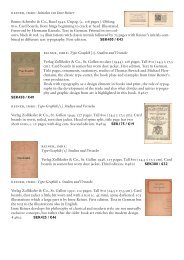
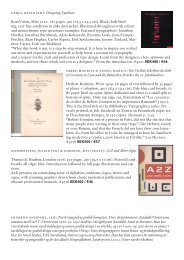
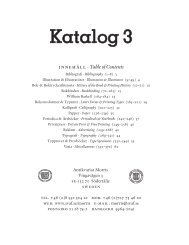
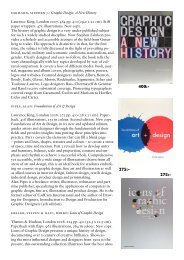

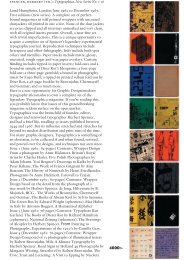
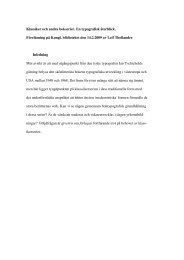
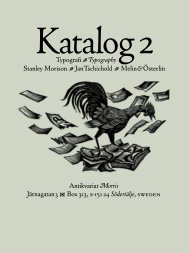
![|melin & österlin]: Olika sidor Reklam ... - Antikvariat Morris](https://img.yumpu.com/17680273/1/184x260/-melin-osterlin-olika-sidor-reklam-antikvariat-morris.jpg?quality=85)
